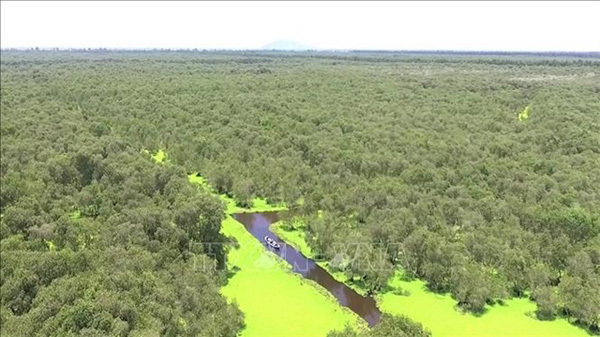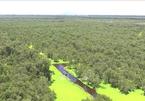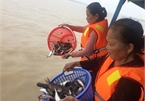 |
| Tra Phu Mangrove in An Giang is an eco-tourism destination. VNA/VNS Photo Thanh Sang |
The country, with traditional agriculture, possesses a large number of original plant varieties and strains with valuable genetic resources.
But at present, biodiversity is at risk of degradation.
Identifying and preventing the causes that impact biodiversity is an essential job.
Severe degradation
According to scientists, the main causes of biodiversity degradation were over-exploitation, which destroyed resources and caused pollution of water, soil and air.
Prof. Nguyen Ngoc Lung, head of the Research Institute for Sustainable Forest Management and Forest Certification, said biodiversity has been rapidly degraded in all three forms of ecosystems, species and genetic sources in both quality and quantity.
Particularly, essential natural ecosystems such as primary forests, mangroves, coral reefs, sea-grass beds, and inland and coastal wetlands have been reducing in area, Lung said.
The compositions and quality of biomes in these ecosystems have been decreased, the professor said.
The total area of natural forest of Vietnam in 1943 was 14.3 million ha with the coverage rate of 43.8 per cent, reaching 33 per cent of the ecological safety norm. But by 1999, the forest area dropped to 10.88 million ha, he said.
The main causes of deforestation are rapid population growth, widespread slash and burn practices for farming, reclamation of land for industrial crops such as coffee, tea, rubber and timbers for export.
The total area of mangroves at present also dropped to 155,000ha as compared to 400,000ha in 1943. And notably, the primary areas accounted for a very small proportion.
The areas of coral reefs, excluding the two archipelagos of Hoang Sa and Truong Sa, reduced sharply to 14,000ha from 110,00ha in 10 years. The quality of the coral reefs was also very poor, and many species died.
Five animal species were extinct in nature and 48 other species are endangered.
In addition, many valuable plant breeds of rice, maize, peanut and soya bean have disappeared.
Along with human causes, biodiversity degradation was also due to impacts of climate change and extreme weather, said Lung.
Ecologists confirmed that negative impacts of climate change on biodiversity increased the pressure on rare species.
Climate change caused high sea levels, which changed marine ecological systems and submerged islands and coastal lands. Forests are also at high risk of fire.
Immediate measures needed
According to scientists of the Vietnam Association for Conservation of Nature and Environment (VACNE), the three issues of biodiversity, climate change and sustainable development must be properly handled to achieve socio-economic development.
Thus, it was necessary to minimise the impacts of climate change on biodiversity and sustainable socio-economic development.
Biodiversity can mitigate climate change and positively impact sustainable development. Meanwhile, sustainable development limits the impacts of climate change and contributes positively to biodiversity, according to scientists.
In order to prevent direct and indirect harm to biodiversity, it is essential to fully and effectively implement the National Strategy on Biodiversity by 2020 with a vision to 2030 by the Prime Minister issued in 2013.
The strategy set out five main tasks: natural ecosystem conservation; wild and rare species conservation; sustainable use and implementation of a rational sharing mechanism for benefits from ecosystem and biodiversity; controlling activities causing negative impacts on biodiversity; and protecting biodiversity in the context of climate change.
However, to stop the harm to biodiversity, the strategy needs to amend some targets because it has not yet fully evaluated the harmful effects of climate change which is happening quickly and unpredictably today. Also, the strategy should mention co-operation between concerned agencies to biodiversity conservation. VNS

An Giang steps up efforts to protect Tra Su cajuput forest
An Giang has approved the Tra Su cajuput forest protection and sustainable management plan for 2019-30 period in a bid to protect the wetland’s eco-systems.

An Giang: 15 tonnes of fish released to protect biodiversity
About 15 tonnes of breeding fish of different varieties, including 193,000 individuals of rare indigenous fish, were released to nature in Vam Nao River in the Mekong Delta province of An Giang on August 10.
 Vietnam’s biodiversity is facing many challenges, especially in the context of global climate change." itemprop="description" />
Vietnam’s biodiversity is facing many challenges, especially in the context of global climate change." itemprop="description" />